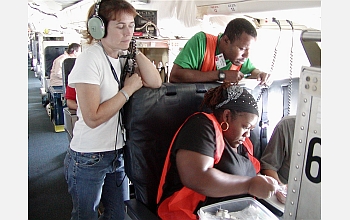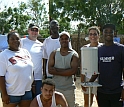|

Press Release 06-168
Graduate Students Study Links Between African and U.S. Weather Systems

NSF-supported program encourages students to broaden their scientific experience with international collaboration
December 6, 2006
When their DC-8 flew into a tropical storm off the coast of West Africa, Aaron Pratt and Tamara Battle realized their lifelong dream--to study storms and weather systems at their source. During that flight, lightning struck their plane. The resulting storm turned into a tropical depression and ultimately became known as Hurricane Helene, one of the strongest Atlantic hurricanes in 2006.
Pratt and Battle were thrilled. They, along with Stephen Chan, Amber Reynolds, Daniel Robertson and Deanne Grant, spent a month conducting weather research in Senegal and Cape Verde, West Africa. The students worked with scientists from universities and government agencies to study how land storms become ocean storms and then make their way west to U.S. and Caribbean waters.
"African dust is very critical for hurricane formation. One of our flights allowed us to see the dust kicked up in the Sahara Desert," said Pratt, who is pursuing a doctorate in atmospheric science from Howard University in Washington, D.C. "I had never done research overseas before and didn't know what to expect. Working with scientists in both Senegal and Cape Verde helped put our research in the proper perspective."
Battle is also a doctoral candidate in atmospheric science at Howard University. "When we flew over the Sahara Desert, it was serene and beautifully simple," she said. "Africa's easterly waves and Saharan dust storms not only impact the weather in the United States and the Caribbean, but they also have implications for the inhabitants of many African countries. By sharing what we've learned, we increase the chances of helping those countries improve forecasting and predictability. That will have a positive impact on the agriculture and economy of the region."
Howard University received a grant from the National Science Foundation (NSF) to support the American students' work with a large multinational team of scientists on a project called African Monsoon Multidisciplinary Analysis (AMMA). Scientists and students from around the world are involved with the project, which is also funded by nations in Africa, Europe and Asia.
The students worked in the air and on the ground. The flights originated in Cape Verde and investigated easterly waves, developing tropical cyclones, Saharan dust outbreaks, convection and cloud microphysics. In Senegal, the students used advanced equipment to track precipitation, predict rainfall and measure air pressure.
"NSF's international office funds projects that give U.S. researchers and students the opportunity to conduct top-notch research while working with international collaborators," said Elizabeth (Libby) Lyons, regional program coordinator for Africa, the Near East and South Asia in NSF's Office of International Science and Engineering. "These kinds of projects help develop a cadre of globally-engaged U.S. scientists and engineers who know how to work with international colleagues and who understand the context in which the research takes place and the impact of its results."
Not only did the students contribute to science in a developing country, they also interacted with villagers in a high-profile field campaign. "This project allowed them to get the first crack at the data and work with top-notch scientists from many nations" said Gregory Jenkins, director of Howard University's Program in Atmospheric Sciences. "The overall experience will make these students better scientists . Throughout their stay in West Africa, they were cognizant of Hurricane Katrina's impacts and how their work might help the United States."
To adapt to their immersion in another culture, the students learned basic Wolof, Senegal's national language, and worked in Kawsara, a village approximately 30 miles southeast of the capital city Dakar. Throughout their stay, they learned to adapt to frequent outages of electricity.
"The logistics were the most challenging part of the project," said Stephen Chan, a graduate student at the University of Virginia. "We took daily trips to the gas station to stock up on gasoline for the generator, and eventually we had to repair the generator because it broke down. But the Senegalese people were always creative and unwilling to quit until a solution was found." The AMMA project was Chan's first field research.
Amber Reynolds, a graduate student at Texas A & M University, plans to return to West Africa in 2007 to work in Dakar. "I'm trying to keep my Wolof skills up-to-date by talking with Senegalese students who attend Texas A&M," Reynolds said. " I learned so much about culture and science. I'm excited to return and continue my research."
The students will present a project overview and initial findings at the annual meeting of the American Meteorological Society in January 2007. In addition to pursuing research for their respective degrees, they also will develop publications in collaboration with their Senegalese colleagues. Challenged by sporadic electricity, the students wanted to learn about solar panels and wind power and may explore whether either alternative could provide basic electricity and water to the local communities they visited.
"It is extremely important for African-American and West African scientists to forge a link in science, just as we are already linked in history," Pratt said. "I will cherish this experience, my first international research experience, and I'll work to make sure this is a beginning of great things, for myself, for Howard University, Senegal, and Cape Verde."
The students' research was funded by NSF's Office of International Science and Engineering and the Division of Atmospheric Sciences.
-NSF-

Media Contacts
Dana Topousis, National Science Foundation (703) 292-7750 dtopousi@nsf.gov
Program Contacts
Elizabeth Lyons, National Science Foundation (703) 292-7256 elyons@nsf.gov
Principal Investigators
Dr. Gregory Jenkins, Howard University (202) 806-5567 gjenkins@howard.edu
Related Websites
NSF Office of International Science and Engineering: http://www.nsf.gov/div/index.jsp?div=OISE
U.S. Component of African Monsoon Multidisciplinary Analyses: http://www.eol.ucar.edu/projects/amma-us/

The National Science Foundation (NSF) is an independent federal agency that supports fundamental research and education across all fields of science and engineering. In fiscal year (FY) 2009, its budget is $9.5 billion, which includes $3.0 billion provided through the American Recovery and Reinvestment Act. NSF funds reach all 50 states through grants to over 1,900 universities and institutions. Each year, NSF receives about 44,400 competitive requests for funding, and makes over 11,500 new funding awards. NSF also awards over $400 million in professional and service contracts yearly.
 Get News Updates by Email Get News Updates by Email
Useful NSF Web Sites:
NSF Home Page: http://www.nsf.gov
NSF News: http://www.nsf.gov/news/
For the News Media: http://www.nsf.gov/news/newsroom.jsp
Science and Engineering Statistics: http://www.nsf.gov/statistics/
Awards Searches: http://www.nsf.gov/awardsearch/
| 



